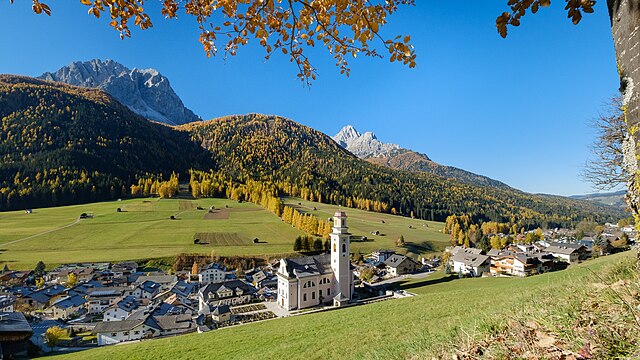Sexten
Contributors to Wikimedia projects
 Article Images
Article Images
Sexten (German pronunciation: [ˈzɛkstn̩]; Italian: Sesto [ˈsɛsto]) is a comune and a village in South Tyrol in northern Italy. The village is famous as a summer and winter sport resort in the mountains.
Sexten | |
|---|---|
| Gemeinde Sexten Comune di Sesto | |
 | |
| Coordinates: 46°42′N 12°21′E / 46.700°N 12.350°E | |
| Country | Italy |
| Region | Trentino-Alto Adige/Südtirol |
| Province | South Tyrol (BZ) |
| Frazioni | Kiniger (Quiniga), Mitterberg (Monte di Mezzo), Schmieden (Ferrara), St. Veit (San Vito), Moos (Moso) |
| Government | |
| • Mayor | Thomas Summerer (SVP) |
| Area | |
| • Total | 80 km2 (30 sq mi) |
| Elevation | 1,310 m (4,300 ft) |
| Population (31-12-2013)[2] | |
| • Total | 1,952 |
| • Density | 24/km2 (63/sq mi) |
| Demonym(s) | German: Sextner Italian: di Sesto |
| Time zone | UTC+1 (CET) |
| • Summer (DST) | UTC+2 (CEST) |
| Postal code | 39030 |
| Dialing code | 0474 |
| Website | Official website |
According to the 2011 census, 95.37% of the population speak German, 4.36% Italian and 0.27% Ladin as first language.[3]
The town sits in a branch of the Puster Valley, near Innichen and Toblach, where the Drava rises. The district borders East Tyrol, Austria, to the north and the border is formed by the Carnic Alps. To the south lie the eponymous Sexten Dolomites and nature park, which includes the famous Drei Zinnen (Tre Cime di Lavaredo).
The commune is bordered, clockwise from the west, by Toblach, Innichen, Sillian (Austria), Kartitsch (Austria), Comelico Superiore (Belluno) and Auronzo di Cadore, (Belluno).
The village's name is of Latin origin: ad horam sextam, meaning "at the sixth hour", referring to its location south of Innichen. Sexta is documented starting from 965 AD, due to its connections to the Bavarian Prince-Bishopric of Freising.[4] During World War I, Sexten was on the front line between Italy and the Austro-Hungarian Empire, and suffered much damage.
It was conquered by Italy in November 1918. Later it received further fortifications during the Fascist Era.
It is the hometown of tennis player Jannik Sinner.
The emblem is azure and represents three argent peaks with a sable chamois standing in the centre; the three peaks symbolize the Tre Cime di Lavaredo. The emblem was granted in 1972 but was in use before World War I.[5]
Sexten is twinned with:
- Sankt Veit in Defereggen, Austria
- Zermatt, Switzerland
- Jannik Sinner (born 2001), tennis player was raised in Sexten
- ^ "Superficie di Comuni Province e Regioni italiane al 9 ottobre 2011". Italian National Institute of Statistics. Retrieved 16 March 2019.
- ^ All demographics and other statistics from the Italian statistical institute (Istat)
- ^ "Volkszählung 2011/Censimento della popolazione 2011". Astat Info (38). Provincial Statistics Institute of the Autonomous Province of South Tyrol: 6–7. June 2012. Retrieved 14 June 2012.
- ^ Martin Bitschnau; Hannes Obermair (2009). Tiroler Urkundenbuch, II. Abteilung: Die Urkunden zur Geschichte des Inn-, Eisack- und Pustertals. Vol. 1: Bis zum Jahr 1140. Innsbruck: Universitätsverlag Wagner. pp. 99–102, no. 134. ISBN 978-3-7030-0469-8.
- ^ Heraldry of the World: Sexten
Media related to Sexten at Wikimedia Commons
- (in German and Italian) Homepage of the municipality



